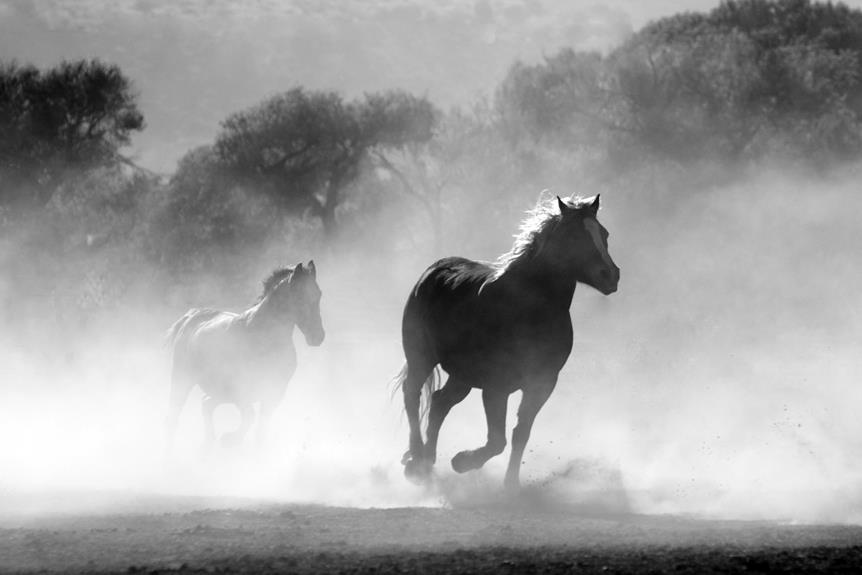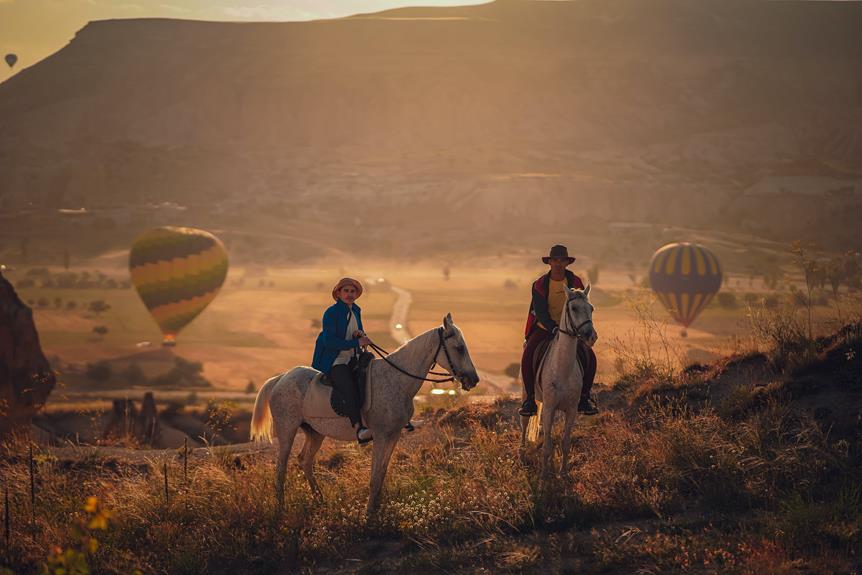Have you ever seen a black and white horse galloping across a field, its contrasting colors creating a captivating sight? These magnificent creatures, known for their distinctive coat patterns, have long been admired for their beauty and grace.
From the elegant Gypsy Vanner to the striking Appaloosa, black and white horses can be found in various breeds, each with its own unique markings.
But there is more to these horses than just their stunning appearance. In this discussion, we will explore the historical significance, characteristics and temperament, care and maintenance, as well as training and riding considerations of these captivating black and white horses.
So, saddle up and let's embark on a journey into the world of these mesmerizing equines.
Key Takeaways
- Black and white horses, also known as piebald or skewbald horses, have a distinct coat pattern caused by a genetic mutation known as the Tobiano gene.
- Various horse breeds, including Gypsy Vanner, American Paint Horse, Shire, Friesian, Drum Horse, and Irish Cob, can exhibit black and white coat patterns.
- Black and white horses have historical significance and symbolism, often representing balance and harmony, and have been associated with royalty and nobility.
- Training and riding black and white horses require patience, consistency, and positive reinforcement, and they can excel in disciplines like dressage, jumping, and driving.
Breeds With Unique Patterns
Breeds with unique patterns include Appaloosa, Knabstrupper, Pony of the Americas, Gypsy Vanner, Gypsy Cob, American Paint, Tennessee Walking Horse, Shetland Pony, Icelandic Horse, Mustang, and Noriker. These breeds are known for their distinct coat patterns, which make them stand out among other horses.
The American Paint Horse is a popular breed known for its striking black and white coat patterns. These horses have large patches of white on their bodies, which contrast beautifully with their solid black or brown base color. Similarly, the Gypsy Vanner and Gypsy Cob breeds are often seen with piebald and skewbald colors, giving them a unique and eye-catching appearance.
The Tennessee Walking Horse is another breed that showcases unique coat patterns. These horses often have pinto patterns, consisting of larger white patches on any other color. This combination of colors adds to their beauty and elegance, making them a favorite among riders in both Western and English disciplines.
Shetland Ponies and Icelandic Horses are known for their resilience and can come in various coat colors, including black with white points. These small but sturdy breeds have adapted to harsh environments and have a rich history of being hardworking and versatile.
Lastly, Mustangs and Norikers are wild-roaming horses with coats of any color and varying coat patterns. Their sure-footedness and muscular build make them suitable for various tasks, such as herding and riding.
Historical Significance
Now let's explore the historical significance behind these remarkable black and white horse breeds.
Throughout history, black and white horses have held great importance in various cultures and time periods. Here are three key reasons why these breeds have left a lasting impact:
- Cultural Influence: The striking coat of black and white horses has captivated people across different societies. From the Nez Perce tribe, who revered the Appaloosa horse that originated from their lands, to the elegant American Saddlebred and the versatile American Paint Horse, these breeds have represented cultural heritage and traditions.
- Versatility and Utility: Black and white horses have played significant roles in agriculture, transportation, and leisure activities. The Shetland Pony, known for its strength and endurance, has been a reliable companion for farmers and a favorite among children. The Miniature Horse, with its distinctive coat, has become popular in exhibitions and as therapy animals.
- Symbolism and Genetic Factors: The unique patterns of black and white horses have long been associated with symbolism and mystique. Their striking appearance has symbolized power, beauty, and freedom. From ancient mythology to modern equestrian competitions, these breeds have stood out for their genetic traits and aesthetic appeal.
Characteristics and Temperament
With their distinctive monochrome coats and captivating presence, black and white horses are known for their striking appearance and diverse temperament. These horses come in a variety of breeds, each with its own unique characteristics and temperament. Here is a table showcasing some popular black and white horse breeds and their notable traits:
| Breed | Characteristics | Temperament |
|---|---|---|
| Paint Horse | White patches on a dark base coat, known for pinto patterns | Versatile, intelligent, and friendly |
| Appaloosa | Black or white spots on a solid base coat | Lively, energetic, and curious |
| Shire | Typically solid black or white, draft horse breed | Gentle, calm, and patient |
| Andalusian | Often gray or black with white markings | Noble, brave, and highly trainable |
| Gypsy Vanner | Beautiful breed with feathered legs and lush mane and tail | Friendly, gentle, and adaptable |
These black and white horses have become popular in various equestrian disciplines, such as dressage and show jumping. Their unique appearance adds a touch of elegance and grace to the arena. Whether you prefer the striking contrast of a solid black and white horse or the intricate patterns of pinto designs, these horses are truly a sight to behold. So, if you're looking for a horse with both beauty and character, a black and white horse might be the perfect choice for you.
Care and Maintenance
Regular care and maintenance are essential for keeping black and white horses healthy and happy. Whether you have a Black Horse or one of the various White Horse Breeds, there are a few things you need to do to ensure their well-being. Here are three important aspects of care and maintenance for black and white horses:
- Grooming: Different coat colors require different grooming techniques. Brushing and combing their coats regularly will help keep them clean and free of tangles. Black horses may need extra attention to prevent sunburn on their dark skin, while white horses may require more frequent bathing to keep their coats bright and stain-free.
- Nutrition: Just like any other horse, black and white horses need a well-balanced diet to thrive. Consult with a veterinarian or equine nutritionist to determine the best feed and supplements for your horse's specific needs. Providing fresh water at all times is also essential for their health.
- Exercise and Turnout: Regular exercise and turnout are vital for black and white horses to maintain their physical fitness and mental well-being. Allow them time to roam and graze in a safe and spacious area. Riding or engaging in other activities with your horse will also help strengthen your bond and keep them happy.
Training and Riding Considerations
When training and riding black and white horses, it's important to consider their unique coat patterns and how they may influence their visibility and perception by other horses.
Black and white horses come in many different patterns, such as paint, pinto, and Appaloosa. Their black and white coloring can make them excellent riding horses, as they stand out in a variety of environments. The black base color combined with patches of white can create a striking contrast that's likely to catch the eye of both riders and other horses. This visibility can be advantageous in situations where you need to be seen, such as during trail rides or in crowded arenas.
In addition to their visibility, black and white horses also come in a variety of beautiful white colors, including gray and roan. These colors can give them a regal and elegant appearance, making them popular choices in the show ring. However, it's important to note that their unique coat patterns may require special considerations when it comes to grooming and maintenance. Regular grooming and proper nutrition are essential to keep their coats looking their best and to maintain their overall health and well-being.
When riding black and white horses, it's crucial to use appropriate tack and equipment that fits well and ensures the comfort of the horse. Proper training and education are also key in developing a good partnership with these horses. Consistent training won't only improve your riding skills, but also help maintain a strong bond with these unique equines.
Frequently Asked Questions
What Is a Black & White Horse Called?
A black and white horse is called a pinto. They have distinctive coat patterns, such as blankets and leopard spots, due to the leopard complex gene. Pintos are popular in various disciplines and have unique characteristics.
What Is a Black and White Spotted Horse Called?
A black and white spotted horse is called a pinto. Pintos have a genetic origin in various horse breeds, and they have been famous throughout history. They require specific training techniques and grooming to maintain their coat.
What Is a Black Horse With White Patches Called?
A black horse with white patches is commonly known as a piebald or skewbald horse. The unique coat pattern is a result of specific genetics. Caring for a black and white horse requires regular grooming and attention to their skin.
What Is a Black Horse With White Hair Called?
A black horse with white hair is called a black horse with white hair. Breeds with black horses and white manes are known for their striking appearance. Celebrities and history have shown the allure of these horses in the show ring.
Conclusion
In conclusion, black and white horses are truly captivating and have a rich history in various breeds. Their unique coat patterns and striking appearance make them stand out in disciplines such as dressage and show jumping.
These horses require proper care and maintenance, and their temperament can vary depending on the breed. With the right training and attention, black and white horses can be wonderful companions for riding enthusiasts.
So, if you're looking for a horse that combines beauty and athleticism, consider a black and white breed.



0 Comments